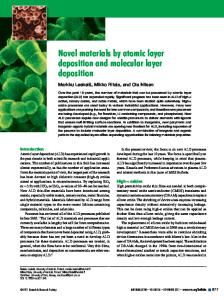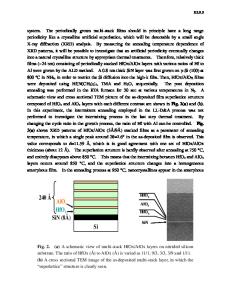Recent advances in the understanding of high- k dielectric materials deposited by atomic layer deposition for dynamic ra
- PDF / 2,057,220 Bytes
- 20 Pages / 584.957 x 782.986 pts Page_size
- 48 Downloads / 824 Views
FOCUS ISSUE
ATOMIC LAYER DEPOSITION FOR EMERGING THIN-FILM MATERIALS AND APPLICATIONS
Recent advances in the understanding of high-k dielectric materials deposited by atomic layer deposition for dynamic random-access memory capacitor applications Woojin Jeon1,a) 1
Department of Advanced Materials Engineering for Information and Electronics, Kyung Hee University, Yongin 17104, Republic of Korea Address all correspondence to this author. e-mail: [email protected]
a)
Received: 7 September 2019; accepted: 15 October 2019
Capacitors represent the largest obstacle to dynamic random-access memory (DRAM) technology evolution because the capacitor properties govern the overall operational characteristics of DRAM devices. Moreover, only the atomic layer deposition (ALD) technique is used for the dielectric and electrode because of its extreme geometry. Various high-k materials deposited by ALD have been investigated for further scaling. Whereas past investigations focused on increasing the physical thickness of the dielectric to suppress leakage current, the physical thickness of the dielectric should also be limited to a few nanometers in design rules less than 1×-nm. Therefore, a new way to overcome the limitations of traditional approaches based on thorough understanding of high-k materials is highly recommended to enhance the properties of conventional materials and provide directions for developing new materials. In this review, previously reported results are discussed, and suggestions are made for further investigations for DRAM capacitor applications.
Introduction Dynamic random-access memory (DRAM) device is the most important device among semiconductor memory devices because of its wide range of applications in the IT industry, which include PCs, servers, and mobile phones. The necessity and importance of DRAM have increased because of the tremendous amount of data to be processed in the big data industry (which is one of the most important industries in the fourth industrial revolution) and the increased demand for various electronic devices [1]. In this regard, the market for DRAM has increased dramatically in the past decades, and this increase has reached unprecedented levels in recent years. As a consequence, research about DRAM devices has attracted a lot of attention from academia and industry. Because the capacitor primarily governs operational characteristics of the DRAM device, most research on DRAM has focused on implementing performance enhancements in the DRAM capacitor. The DRAM capacitor, which consists of a metal–insulator–metal (MIM) structure, requires low leakage current density and high capacitance density for robust operations (e.g., read, write, and refresh). In the early stages of development, decreasing the
ª Materials Research Society 2019
dielectric thickness or increasing the capacitance area by changing the structure of the MIM capacitor could be used to meet the specifications of DRAM capacitors [2, 3]. However, using dielectric materials with a high dielectric constant (k)
Data Loading...











